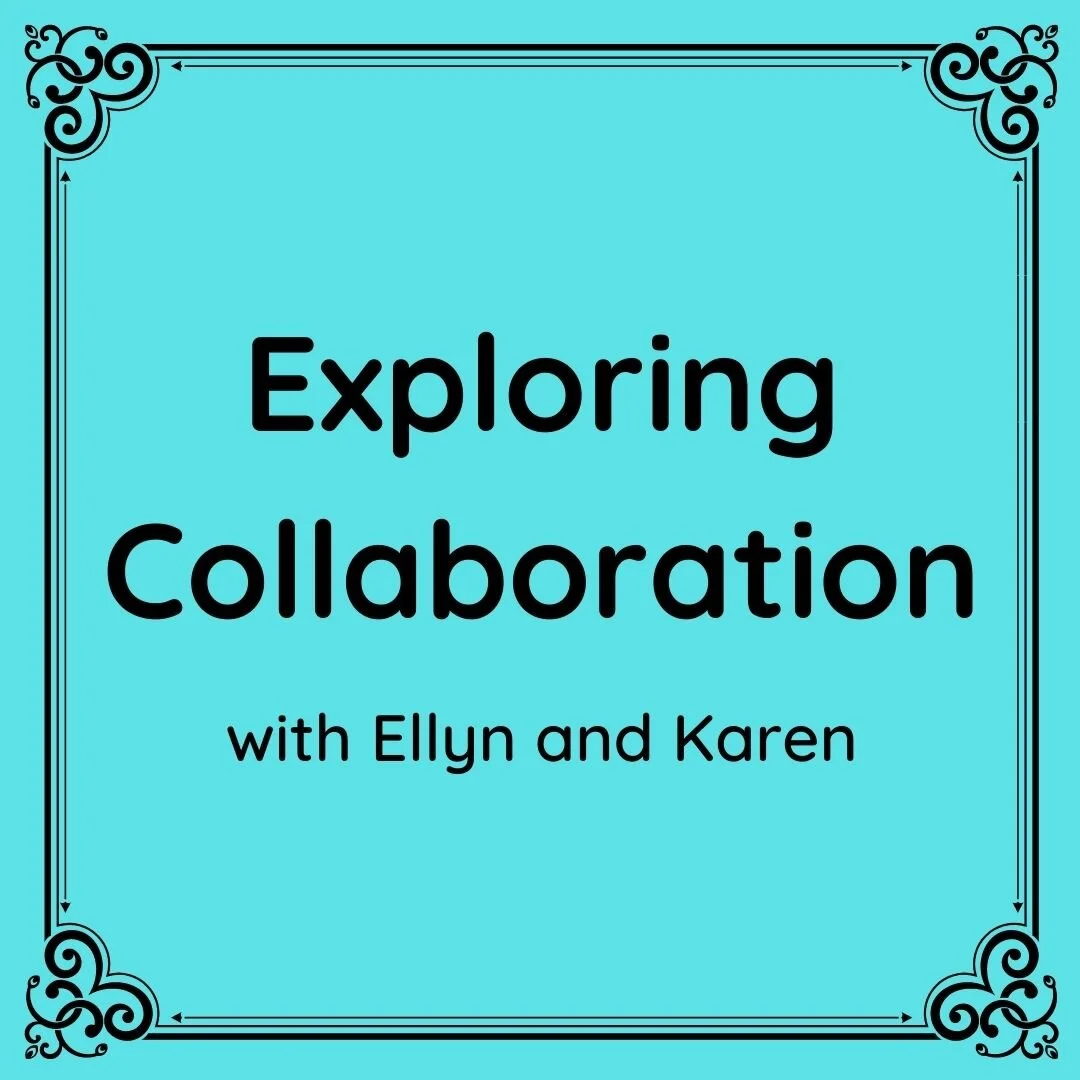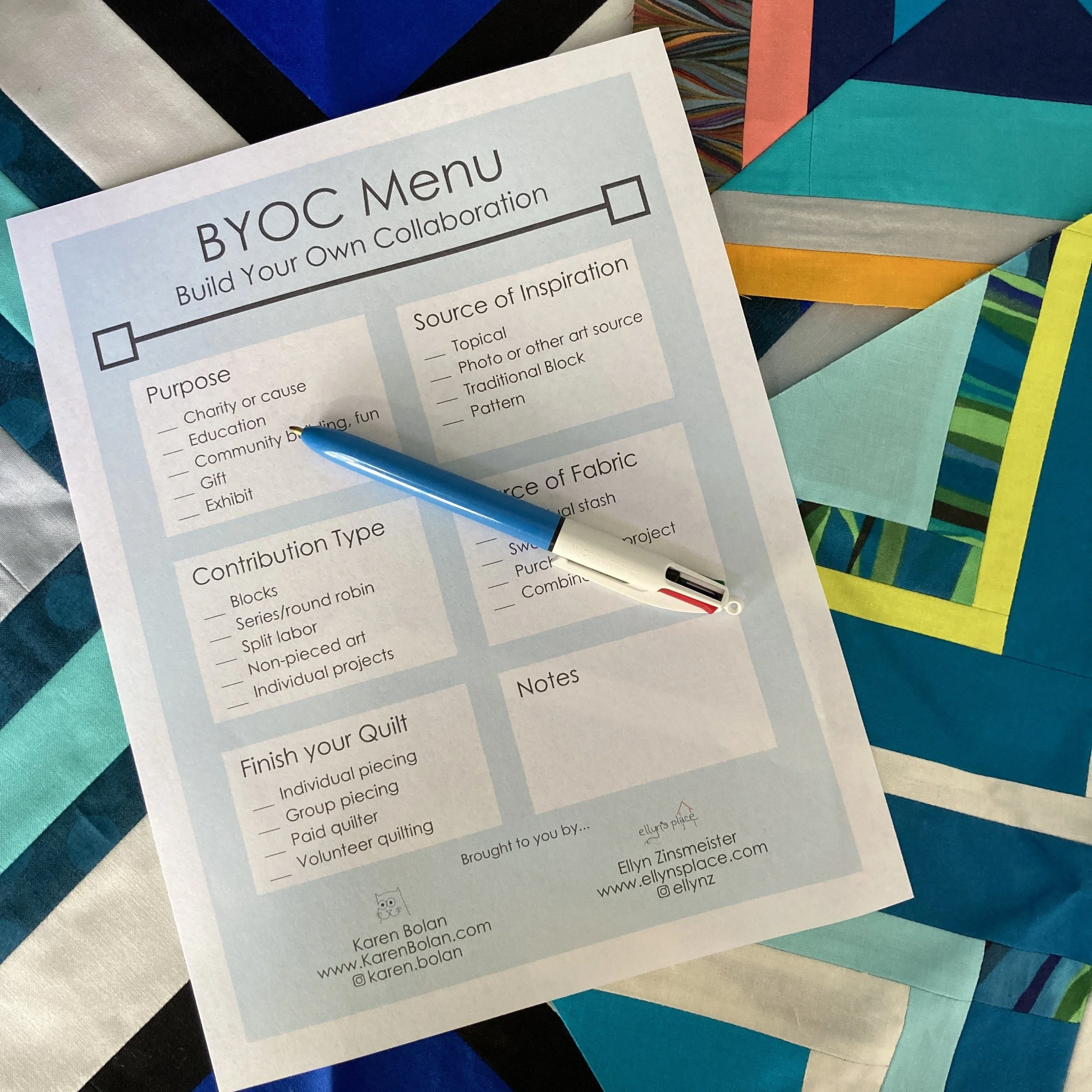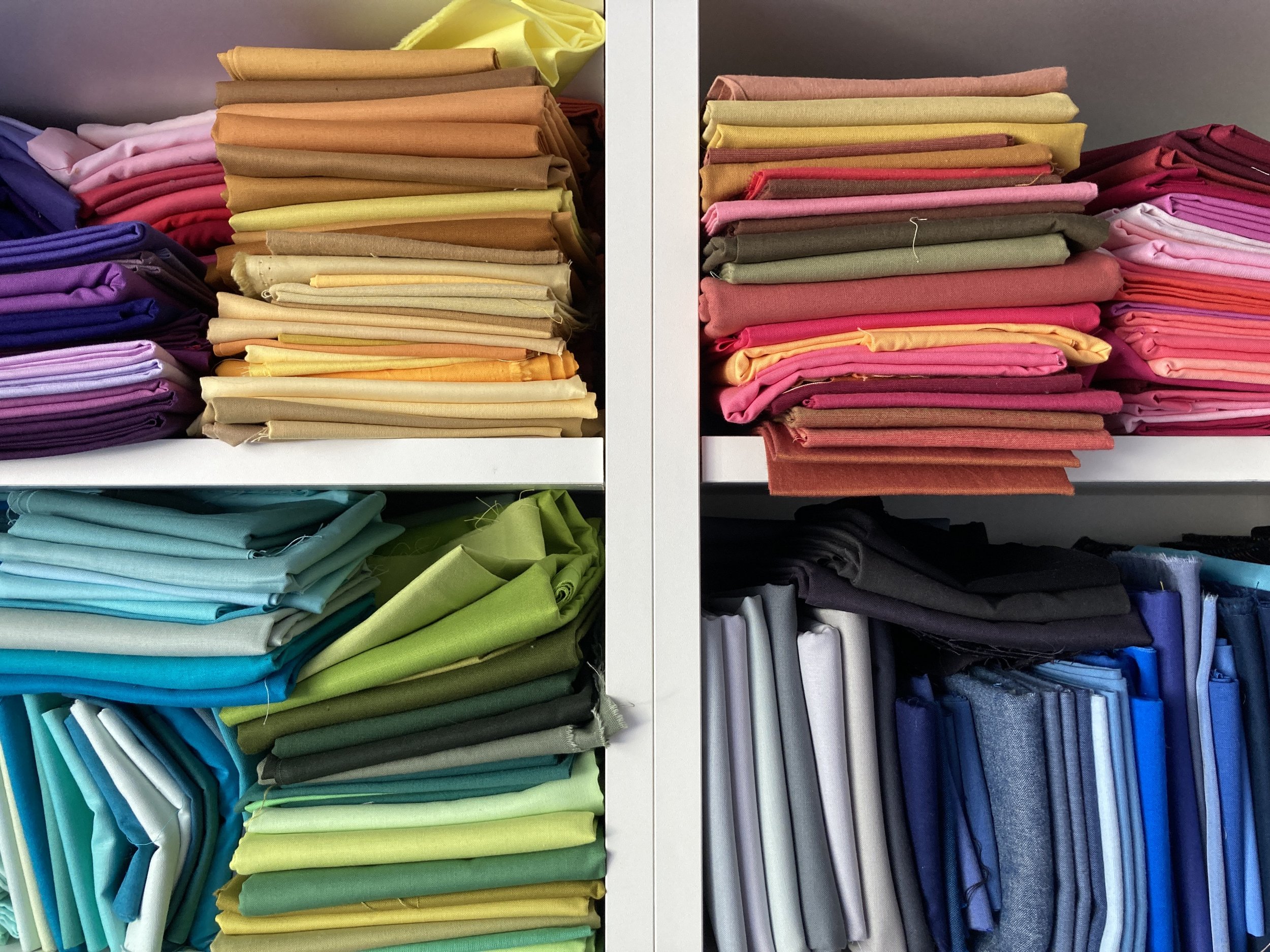Exploring Collaboration Part 6 - BYOC (Build Your Own Collaboration)
About this collaboration series
Ellyn Zinsmeister and I love exploring collaboration, and to share that love we are preparing a series of blog posts about collaboration. Twice a month, on the first and third Wednesdays, we have been covering related topics from our own perspectives. This series began with an overview of two types of quilting collaborations – block swaps (over on Ellyn’s Space) and series collaborations. We shared tips and techniques for successful collaborations, with Ellyn focusing on setting up bees and swaps and me focusing on series collaborations and some specific tips for working with round robins. Then, we investigated some myths that might dissuade you from collaborating. I covered “I’m not good enough to contribute to that project” and “I will receive wrong-sized/colored/sewn blocks” and Ellyn covered “Other people will not follow through” and “I won’t get enough blocks to make a functional quilt.” We each shared a fun collaboration activity; Ellyn explored an in-person activity and I shared a virtual activity. In Part 5, we both shared the beginnings of our new collaborative project. The design of our next project is a first for both of us, and we are using a tool we developed: the Build Your Own Collaboration Menu (BYOC Menu). Today we are sharing the BYOC menu with you! Read on to learn about it in my words, but don’t miss Ellyn’s perspective.
Build Your Own Collaboration
When Ellyn and I were brainstorming for future collaborations, including proposals to publish articles in magazines, I started to organize some of my thoughts in the form of a list of things to consider at each stage of a collaboration. From this, we refined and developed the BYOC Menu, a “Build your own Collaboration” menu (modeled after a sandwich shop order form) to use when designing a collaborative quilting project. Today, we are sharing it with the world!
BYOC Menu
Use the BYOC Menu to Build Your Own Collaboration quilt project. With the help of this guide, make decisions at the beginning of the project about project purpose, source of inspiration, contribution type, source of fabric, and finishing.
Get your own
Download your printable copy from my shop. It’s free for the first month. If you’re new here, thanks for stopping by! Please sign up for my infrequent email newsletter so you don’t miss the latest updates.
Track me down at QuiltCon. Ellyn and I will be there all four days, and we’ll have a limited supply of bookmarks printed with the BYOC menu to hand out.
Purpose
One of the most important needs of a successful collaboration is to organize all parts around the central theme of the project. The Purpose section is where you decide why you’re doing the project. You could be making a charity quilt (for comfort, fundraising or awareness); a quilt for education (of the contributors or the public); a quilt for community building or fun (it’s OK to have fun!); a quilt to gift to a loved one or to award hard work; or a quilt for exhibit at a gallery or show. Don’t forget that it’s acceptable (and common) to choose more than one of these reasons to work on the project. Also consider if there are any other purposes for the project and feel free to write them in. Being clear about the purpose of a project is important for group investment in the project and can be a good motivation to complete it.
Source of Inspiration
Finding a source of inspiration can be challenging for me, and I’ve found it helpful to think about this list of possible sources. When we say topical source, we mean choosing a topic to inspire the quilt (like the new collaboration Ellyn and I are starting). The next three sources are common in the quilting world, but come with a reminder to respect others’ copyright*. Photos or other art sources can be fantastic inspiration, for colors, shapes, feelings, and proportion; always ask the artist before reinterpreting their artwork*, or use your own original art. Traditional blocks and block elements are a great choice for new and experienced quilters alike, and can make for wonderful collaborative quilts. When using a quilt pattern for inspiration or for instructions, make sure the designer has given permission* and make sure every person contributing to the project has purchased the pattern*.
* A note about copyright: I am not trying to be Captain of the Quilt Police here; I am merely reminding you about best practices. I know that quilting has a long tradition of generous sharing, which is one of the things I love about the culture of quilters. That said, it has become more widely understood now than before that quilters’ work is artwork and should be protected and respected as such. You can do that by always crediting inspiration sources and supporting the artist(s) responsible by respecting their copyrights and paying for their intellectual property by the method(s) they choose to be compensated.
Contribution type
Deciding on the type of contribution, and making it clear to all involved, is another key to success. Block contributions are common, especially in traditional quilts, with bees and guild projects. Specify the number of blocks, size, design, and accuracy requirements up front to minimize frustration. My personal favorite, a series collaboration, could include round robin- or row-style contributions, but also blocks (remember, we can check multiple boxes in each category). Split labor is usually reserved for smaller group collaborations, where a full design is split and assigned to a few people, and is especially fun when working improvisationally in-person. We included non-pieced art as an option here because many wonderful collaborative projects have been made possible with contributions from non-quilters. The contribution could be an artwork that is then interpreted in quilt form by a quilter, paper blocks, signature blocks, and pretty much anything else you can imagine. Finally, individual projects are possible contributions to a collaborative quilting project, for example in a telephone quilt project.
Source of fabric
Where the fabric comes from is highly dependent on the group contributing. If you’re working with established quilters, individual stash is likely a safe bet if you remember to expect variation in color and possibly quality. A fun activity I’ve done a few times in a few different ways is a fabric swap. Whether you’re swapping “ugly” fabric or “special” fabric, this is a good way to explore something outside your usual comfort zone. For a consistent finished result, fabric can be purchased specifically for the project and distributed to participants, and could make up the full amount required or just part of it. Therefore, combination is the last option here because there are so many ways to approach fabric selection.
Ahhh, shelves full of my somewhat-organized solids stash.
Finish your quilt
When starting a group quilt, it can be especially important to plan out the completion of the quilt, not just to make sure it happens, but to set clear expectations for the team. Maybe individual quilts are being made, or blocks are being sent to one person for assembly. Maybe several people are getting together to sew it all together. When it comes to quilting, you can choose to pay a quilter (if your group agrees to the cost), find a volunteer from the group or outside to quilt it (perhaps someone who wants to contribute but can’t provide a pieced contribution), or the classic quilting bee, where multiple people gather to quilt by hand together. Note that depending on the project, quilting may be interpreted fairly loosely and should of course always align with the purpose and expected use of the finished quilt. While it’s not listed on the menu, don’t forget about binding and labeling the finished quilt.
What isn’t on the menu
Or maybe we should say, “Did you know about the secret menu?” The BYOC menu doesn’t include absolutely everything. We don’t have a line for team selection or deadlines, but those are both crucial to the process and should be documented.
The team selection is usually considered at the beginning of the project, either before or after Purpose and Inspiration.
When working with a preexisting group, the team is either the full group or a subset of volunteers from the group. The Purpose and Inspiration often come after the team selection because the team is already established. One example is a quilting bee, with a defined number of members, who each take turns as the “queen” for a month; the team is established, and it is up to the “queen” to decide on Purpose and Inspiration.
Some collaborations, especially those that include non-quilters, start with the Purpose and Inspiration, then decide on a team later. For example, the AIDS Memorial Quilt started with the heartbreaking Purpose and Inspiration, and community members joined in from around the country upon hearing about the project.
Whether selected before or after, the team selection, Contribution Type, and Source of Fabric depend on each other. For a team of quilters in a bee, the team selection was probably made with assumptions about Contribution Type and Source of Fabric built in. For a community project, the Contribution Type and Source of Fabric must be considered dependent on the team’s ability and access to materials.
Deadlines are (hopefully) of obvious importance to completing a successful project. Deadlines may be externally-set, like for a quilt exhibit, or internally-set, like for a community project. It’s important to decide on not only on a “finish” deadline, but on some intermediate deadlines that make sense for the project, like team selection, fabric ordered, blocks complete, quilting done, etc. The deadlines should be reasonable to accommodate expected delays (think shipping), and a variety of times required for the variety of team members.
Did you download it yet?
Now I want to hear from you
Did you download your copy already? How fun is this? Design your next collaboration project with the BYOC Menu and share about it in the comments.
Looking for more?
Did you know I teach and lecture for quilt guilds? If you are interested in seeing more from me about collaboration, check out my Collaboration is Fun lecture. Ask your guild program chair to reach out and book a class.
Don’t forget to sign up for my email newsletter.






